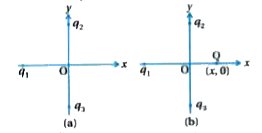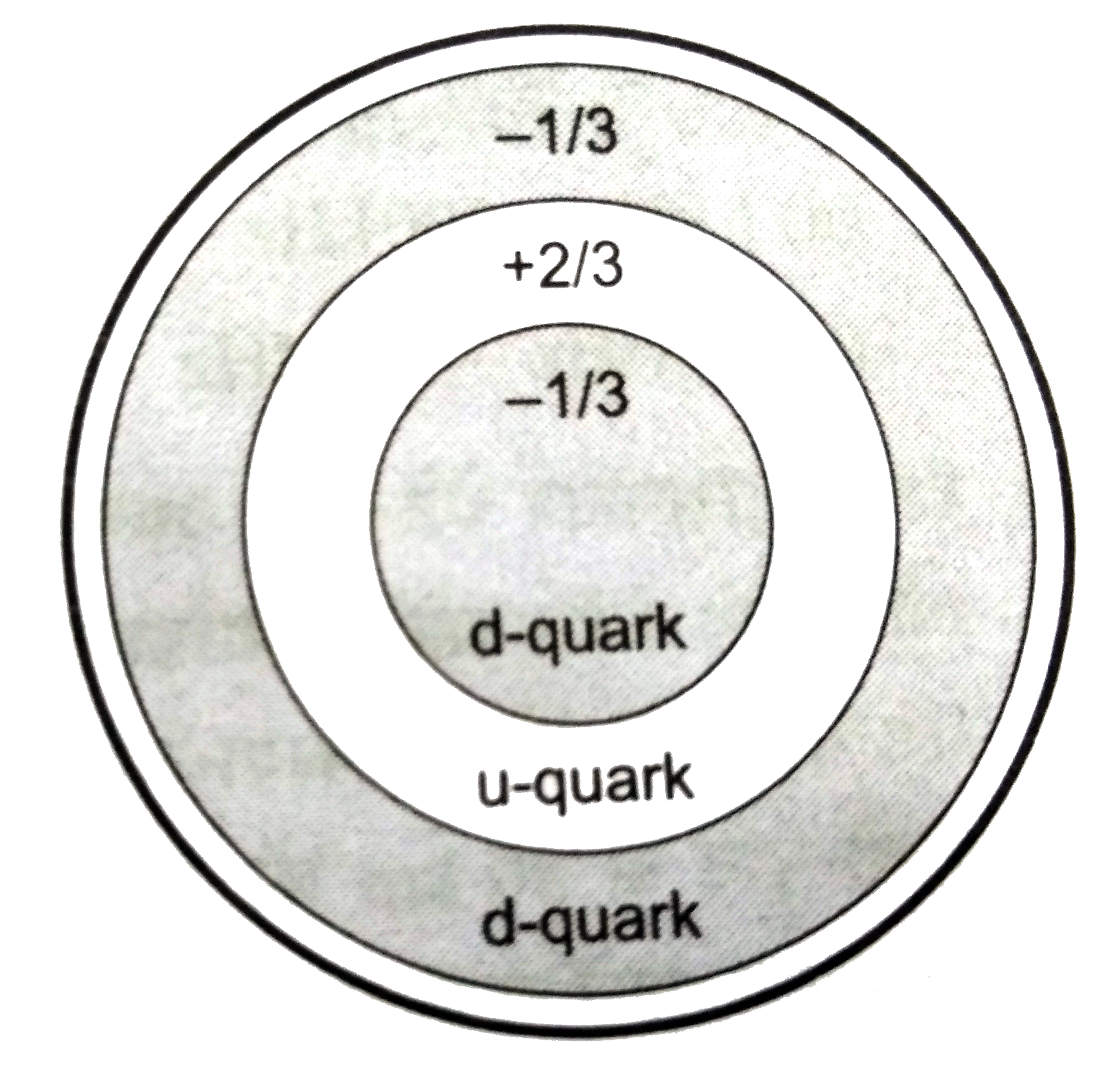It is now believed that protons and neutrons (which constitute nuclei of ordinary matter) are themselves built out of more elementary units called quarks. A proton and a neutron consist of three quarks each. Two types of quarks, the so called 'up' quark (denoted by u)
of charge +23e and the down quark denoted by d) of charge (−13e), together with electrons build up ordinary matter. (Quarks of other types have also been found which give rise to different unusual varieties of matter.) Suggest a possible quark composition of a proton and neutron.Solution in Gujrati
Quark composition of proton : Suppose one proton is made up of n1 no. of up quark and n2 no. of down quark. Hence, Charge of one proton = n1 (charge of one up quark) +n2 (charge of one down quark)
∴e=n1(2e3)+n2(−e2)..........(1)
But we are given that n1+n2=3
∴n2=3−n1.............(2)
From eqns. (1) and (2),
e=n12e3+(3−n1)(−e3)
∴e=2n1e3−e+n1e3
∴n1e=2e
∴n1≡2......(3)
From eqns. (2) and (3)
n2=3−2...........(4)
∴n2=1
Thus, one proton is made up of 2 up quarks and 1 down quark. Hence, quark composition of proton can be shown as "uud" where u = up quark and d = down quark.
Quark composition of one neutron : Suppose one neutron is made up of n1 no. of up quarks and n2 no. of down quarks. Hence, Charge of one neutron = n1 (charge of one up quark) + n2 (charge of one down quark)
∴O=n1(2e3)+n2(−e3)...........(5)
But we are given that n1+n2=3
∴n2=3−n1........(6)
From eqn. (5) and (6)
O=n1(2e3)+(3−n2)(−e3)
∴n1=1...........(7)
From eqn. (6) and (7)
n2=3−1
∴n2=2...........(8)
Thus, one neutron is made up of 1 up quark and 2 down quarks. Hence, quark composition of neutron can be shown as "udd".
Topper's Solved these Questions
- BOOK - KUMAR PRAKASHANCHAPTER - ELECTRIC CHARGES AND FIELDS EXERCISE - SECTION B NUMERICALS (NUMERICAL FOR .DARPAN. BASED ON TEXTBOOK)8videos
ELECTRIC CHARGES AND FIELDS
- BOOK - KUMAR PRAKASHANCHAPTER - ELECTRIC CHARGES AND FIELDS EXERCISE - SECTION C NCERT EXEMPLAR SOLUTION (MULTIPLE CHOICE QUESTIONS (MCQs))7videos
ELECTRIC CHARGES AND FIELDS
- BOOK - KUMAR PRAKASHANCHAPTER - ELECTRIC CHARGES AND FIELDS EXERCISE - SECTION B NUMERICALS (NUMERICAL FROM TEXTUAL EXERCISES)24videos
ELECTRIC CHARGES AND FIELDS
- BOOK - KUMAR PRAKASHANCHAPTER - DUAL NATURE OF RADIATION AND MATTEREXERCISE - Section-D (MCQs asked in GUJCET/Board Exam)1videos
DUAL NATURE OF RADIATION AND MATTER
- BOOK - KUMAR PRAKASHANCHAPTER - ELECTROMAGNETIC INDUCTIONEXERCISE - Section D MCQs (MCQs asked in Competitive Exams )38videos
ELECTROMAGNETIC INDUCTION
Similar Questions
Two spheres of copper, having mass 1 g each, are kept 1 m apart. The number of electrons in them are 1 % less than the number of protons. The electrical force between them is Atomic wt. of copper is 63.54 g/mol, atomic number is 29, Avogadro's number NA=6.023×1023mol−1 and k=9×109 SI
05:32View SolutionIn figure, two positive charges q2 and q3 fixed along the y-axis, exert a net electric force in the + x direction on a charge q1 fixed along the x-axis. If a positive charge Q is added at (x, 0), the force on q1
 07:14View Solution
07:14View SolutionWhat is the force between two small charged spheres having charges of 2×10−7C and 3×10−7 C placed 30 cm apart in air ?
05:48View SolutionMass of photon in motion is ………
05:39View SolutionThree pure inductance each of 3 H are connected as shown in figure. The equivalent inductance of this connection between points A and B is ......
 04:37View Solution
04:37View SolutionIt is now believed that protons and neutrons (which consitude nuclel of ordinary matter) are themselves built out of more elementary units called quarks. A proton and a neutron consits os three quarks each. Two types of quarks , the so called 'up' quark, (denoted by U) of charge + (2//3) e and the 'down' quark (denoted by d) of charge (-1//3) e together with electrons build up ordinary matter. (Quarks of each other types have also been found which give rise to different unsual varieties of matter). Suggest a possible quark composition of a proton and neutron.
05:19View Solutionअब ऐसा विश्वास किया जाता है की स्वयं प्रोटॉन एवं न्यूट्रॉन (जो सामान्य द्रव्य के नाभिकों को निर्माण करते है ) और अधिक मूल इकाइयों जिन्हे क्वार्क से मिलकर बनता है । दो प्रकार के क्वार्क होते है : आप क्वार्क (u निर्दिष्ट द्वारा निर्दिष्ट ) जिन पर +(2/3)e आवेश तथा 'डाउन ' क्वार्क ( d दो निर्दिष्ट ) जिन पर (-1/3)e आवेश होता है , इलेक्ट्रान से मिलकर सामन्य द्रव्य बनाते है । ( कुछ अन्य प्रकार के क्वार्क भी पाए गए है जो भिन्न असमान्य द्रव्य बनाते है। ) प्रोटॉन तथा न्यूट्रॉन के संभावित क्वार्क संघटन सुझाइए ।
02:53View Solutionअब ऐसा विश्वास किया जाता है की सवंय प्रोटोन पर न्यूट्रॉन (जो सामान्य द्रव्य के नाभिको का निर्माण करते है) और अधिक मूल इकाइओ, जिन्हे क्वार्क कहते है, के बने है। प्रत्येक प्रोटोन तथा न्यूट्रॉन तीन कवको से मिलकर बनता है। दो प्रकार के क्वार्क होते है- आप क्वार्क [u द्वारा प्रदर्शित] जिन पर +(23)e आवेश तथा डाउन क्वार्क (d द्वारा प्रदर्शित) जिन पर (−e3) आवेश होता है। इलेक्ट्रान से मिलकर द्रव्य का निर्माण करते है। *(कुछ अन्य प्रकार के क्वार्क भी पाए गए है जो भिन्न असामान्य प्रकार का द्रव्य बनाये है।) प्रोटोन तथा न्यूट्रॉन के संभावित क्वार्क संघटन सुझाइये।
View Solutionन्यूट्रॉन एक अनावेशित परंतु 9.66×10−27Am2 का z - अक्षीय चुंबकीय आघूर्ण (magnetic moment) रखनेवाला कण हैं । इसे न्यूट्रॉन के आंतरिक बनावट से समझा जा सकता हैं । प्रायोगिक सत्यापन से यह ज्ञात हुआ हैं कि एक न्यूट्रॉन तीन मूलभूत क्वार्क एक +23e आवेश के अप - क्वार्क (u) तथा दो −13e आवेश के डाउन - क्वार्क (d) से मिलकर बना हैं । तीनों क्वार्कों का युग्म इसे अनावेशित बनाता हैं । यदि ये क्वार्क गित में हो , तो एक चुंबकीय आघूर्ण उत्पन्न करते हैं । इस साधारण संरचना में यदि यह माना जाए कि u - क्वार्क घड़ी की दिशा की विपरीत दिशा में जबकि d - क्वार्क घड़ी की दिशा से r त्रिज्या वाले वृत्तीय पथ पर एक समरुप चाल v से चलते हैं , तो निम्नलिखित प्रश्नों के उत्तर दें ।

u - क्वार्क के घूमने के कारण उत्पन्न विद्युत -धारा का मान होगा02:50View SolutionIt is now believed that protons and neutrons (which constitute nuclei of ordinary matter) are themselves built out of more elementary units called quarks. A proton and a neutron consist of three quarks each. Two types of quarks, the so called 'up' quark (denoted by u) of charge + (2/3)e and the 'down' quark (denoted by d) of charge (-1/3) e, together with electrons build up ordinary matter. (Quarks of other types have also been found which give rise to different unusual varieties of matter.) Suggest a possible quark composition of a proton and neutron.
07:19View SolutionIt is now believed that protons and neutrons ( which constitute nucleI of ordinary matter ) are themselves built out of more elementary units called quarks. A proton and a neutron consist of three quarks each. Two types of quarks, the so called 'up' quark ( denoted by 'u') and 'down' quark ( denoted by 'd') of charge 23e and −13e respectively , together with electrons build up ordinary matter. Suggest a possible quark composition of a proton and a neutron.
View Solutionमूल कणों के क्वार्क मॉडल में एक प्रोटॉन, दो “अप " क्वार्क, प्रत्येक का आवेश + (2e/3) और एक " डाउन " क्चार्क, आवेश (-e/3) का बना हुआ माना जाता है। मानाकि तीनों क्वार्क समान दूरियों (दूरी = r ) पर स्थित हैं तब इस निकाय की विद्युत स्थितिज. ऊर्जा क्या होगी?
View SolutionIt is now established that protons and neutrons are themselves built out of more elementary units called quarks a proton and a neutron consist of three quarks each together with electrons build up ordinary matter suggest a possible quark composition of a proton and neutron
02:01View SolutionIt is now established that protons and neutrons are themselves built out of more elementary units called quarks a proton and a neutron consist of three quarks each together with electrons build up ordinary matter suggest a possible quark composition of a proton and neutron
07:55View SolutionIt is now believed that protons and neutrons (which constitute nuclei of ordinary matter) are themselves built out of more elementary units called quarks. A proton and a neutron consist of three quarks each. Two types of quarks , the so called 'up' quark, (denoted by U) of charge +(2/3) e and the 'down' quark (denoted by d) of charge (−1/3) e together with electrons build up ordinary matter. (Quarks of each other types have also been found which give rise to different unusual varieties of matter). Suggest a possible quark composition of a proton and neutron.
01:27View Solution

